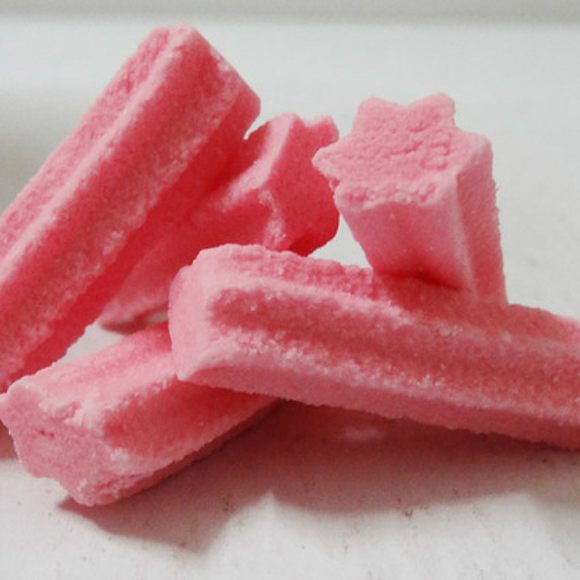Sweets
Musk Sticks
This classic Australian candy looks like pink toothpaste and tastes like perfume.
Few corner store treats are as polarizing as the musk stick. While many Australians and New Zealanders love this vintage candy for nostalgic reasons, others detest its shocking perfume flavor.
Musk sticks are fairy-pink cylinders that resemble extruded toothpaste. They’re made mostly of musk essence, gelatin, and icing sugar, which gives them a semi-soft and powdery, fondant-like feel. Their dissolvable quality (similar to that of Altoids or Conversation Hearts) also means they can be “twisted on your tongue into a sharp point and used to stab your mate,” as one woman fondly recalled from childhood.
Hate it or love it, the association between musk sticks and perfume is hard to shake. Reactions inevitably involve comparisons to deodorant sticks and the smell of old ladies at the bus stop, and the latter comes from a positive review. Musk is the name given to glandular secretions from certain species of oxen, rats, ducks, shrews, beetles, and musk deer. Considered a luxury cosmetic additive, it eventually endangered musk deer, leading some countries to ban it use. Perfumers now use musk essence, a synthetic compound. So do candy makers seeking animal gland scent for their treats.
While the Kiwi and Australian affection for musk candy may seem an anomaly, the two countries are actually holding on to a longstanding, global taste for musky treats. A medieval, Arab recipe for a treat of sugar, honey, pistachios, rosewater, and musk calls the result “as delicious as can be,” while the British made musk lozenges that lovers used to sweeten their breath before a kiss.
Written By
 rachelrummel
rachelrummel
Sources
- www.vice.com/en_us/article/yvxg4v/photographing-the-last-of-the-milk-bars
- matadornetwork.com/nights/wasabi-bugs-and-musk-15-strange-candies-from-around-the-world/
- www.smh.com.au/lifestyle/home/food/nostalgia-alert-our-favourite-lollies-20130129-2djtv.html
- www.candyblog.net/blog/item/musk_sticks
- en.wikisource.org/wiki/1911_Encyclop%C3%A6dia_Britannica/Musk
- news.nationalgeographic.com/news/2004/09/0907_040907_muskdeer_2.html
- www.theherald.com.au/story/1270955/hail-our-favourite-lollies/
- books.google.com/books?id=if5fAwAAQBAJ&dq
- www.newenglandhistoricalsociety.com/sweet-story-conversation-hearts/
- books.google.com/books?id=YHj-Mdv432UC
- books.google.com/books?id=EbHYAAAAMAAJ&q=Medieval+Arab+Cookery:+Essays+and+Translations
















